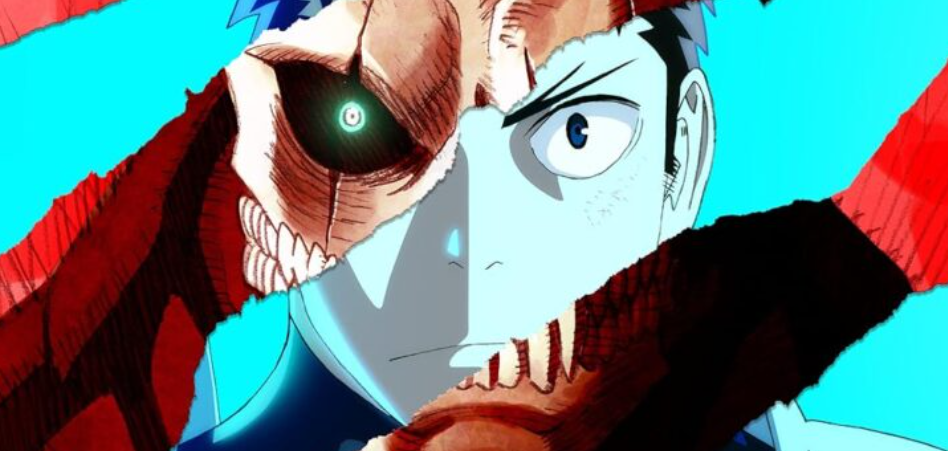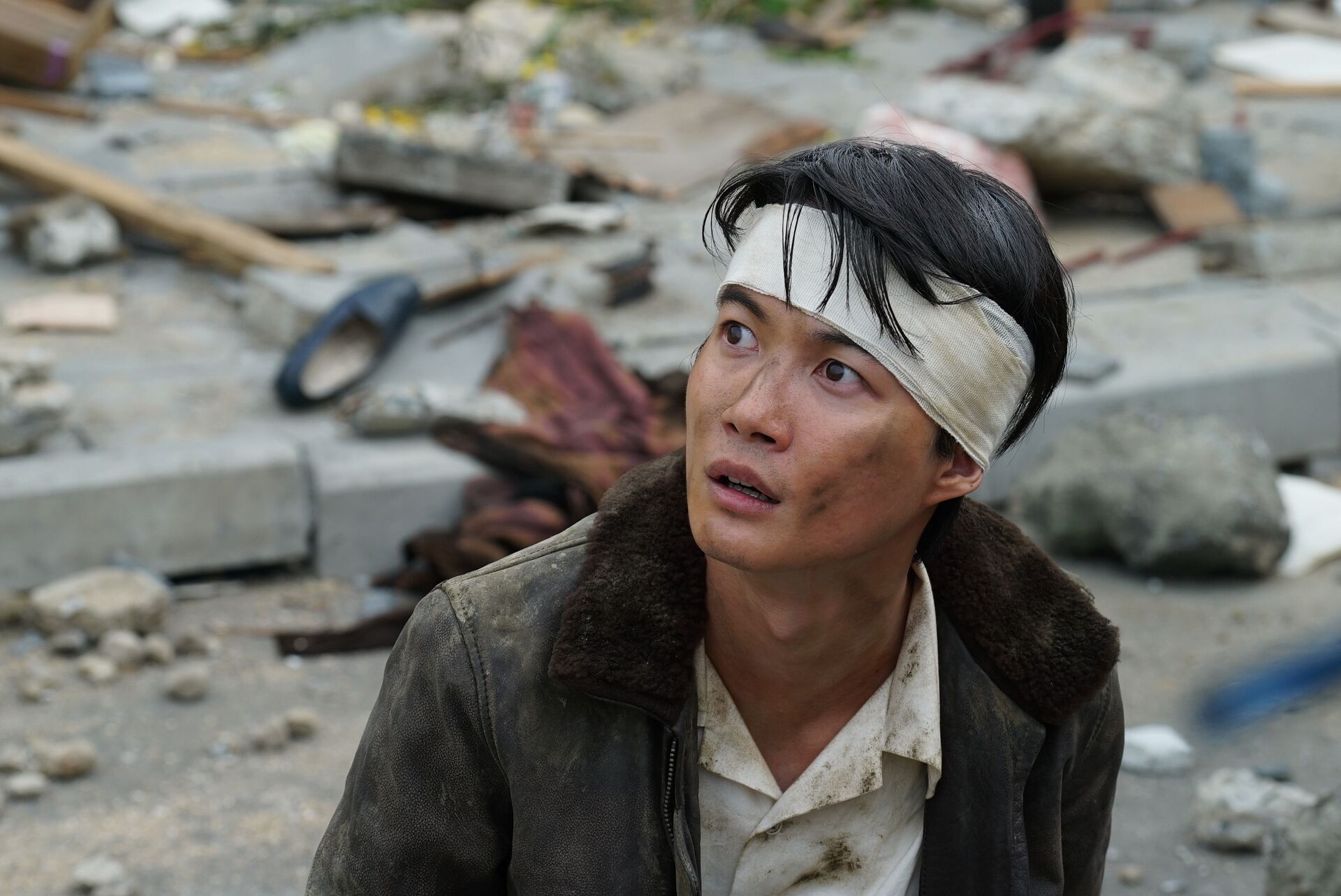An excavation company strip mining a small village becomes the center of controversy and turmoil, when two feuding workers , the bullish Yoshi and the younger Goro, go missing, while concurrently, a series of earthquakes cause the operation’s tunnels to flood.
At first, authorities suspect the still missing Goro of homicide, after Yoshi turns up dead, with a vicious flesh rending slash across his torso . Amidst the already chaotic landscape, rhino-sized insect like creatures show up, the Meganurons, released from the heaving earth, wreaking havoc, and killing three more miners. It then becomes apparent to authorities and townsfolk the workers murders was not by human hands.
The action escalates, as authorities enter the tunnels, heavy weaponry in tow, to eradicate the pestilent vermin, and the missing Goro is found, injured and suffering from amnesia. Absolved of guilt, the gathered scientists, authorities, and company managers focus their efforts on the threatening infestation. Time for a “bug hunt”.
Little do any of them know…a far greater threat is about to reveal itself.
Soon, adding to the misery index, an unknown object is spotted streaking through the skies, moving unnaturally fast, and jet fighters are deployed. A pursuit aircraft is demolished in a collision with the mysterious force, and here is where we, the viewer, get our first gloriously horrifying glimpse of RODAN!
Air control tracks the (to them) still mysterious aerial threat, as warnings are issued to the general public. Soon reports are pouring in from around the eastern hemisphere of the globe, with Tokyo, Peking, and the Philippines, all reporting the anomaly.
Meanwhile, Amnesiac Goro’s memory begins to return. As he gains clarity, recollections of his time trapped in tha caves with the Meganurons become more clear, and repressed terrifying memories of seeing them consumed by an even more horrifying beast, which hatches from a car sized egg, emerge.
From here on out, we get what we initially came for, giant monster action with razor sharp teeth, during the films remaining second half.
RODAN’s narrative is dense, with a lot packed into its lean 82 minute runtime, with some interesting additions to themes being added following director Ishiro Honda’s previous kaiju epic, GOJIRA. While GOJIRA wraps its title creature in duel metaphor, embodying both the threat of atomic weaponry, as well as the anger and sorrow of those victimized from its use, the threat is external. In RODAN, we see a flip, to an almost self-condemning sentiment, as greedy corporations ruin the quaint and beautiful environment of the small village, and its characters full of suspicion and ready to point the finger of blame at one of their own far too quickly. Here, the eventual monstrous threats that come into play do not rise from the sea, appearing over the horizon, and landing like a bomb on Tokyo shores. They come, literally, from within, crashing up from beneath the feet of the Kyushu population, after festering there for what may be millenia, released by the industrial efforts of so called progress.
Comparison’s to the classic 1954 American sci-fi film THEM! are pretty obvious, with the Meganuron’s being an easily identified avatar for THEM!s giant ants, and Kuyushu being a stand-in for THEM!s small New Mexico desert town. Yet, more oddly, after watching RODAN again (a couple of times), as I wrote this piece I also started picking up notes of films that would oddly enough, come later. Namely JAWS, and James Cameron’s ALIENS, through a few scenes that were either reminiscent of, or downright prophetic, regarding those two classics yet to come.
In particular, the first autopsy scene, which is unflinching in its gruesomeness for its 1956 release date, as the mauled Goro, discolored fruiting flesh and all, is laid on full display, the dialog of the scene arguably playing out like that of the one in JAWS, when the character of Matt Hooper examines the unfortunate remains of the sharks first victim.
Later, we get a scene in which the military and authorities enter the mining tunnels, going after the Meganurons, setting up a Gatling gun at a bottleneck in the cavern, in hopes of eradicating the insidious insects with superior firepower. This reminds me greatly of the scene in THEM! with the army going after the giant ants beneath the Arizona sands, also later referenced in the directors cut of ALIENS in which the space marines set up the rail gun at an entryway, counting down remaining ammo reserves against the number of remaining xenomorphs. To add, the even more recent NOPE, by Jordan Peele…spoiler alert…was RODAN an influence as far as the ufo-revealed-to-be-a-biological-entity plot point? It’s mighty close, when you think about it.
All more likely to do with the structure of mystery, tension, and action than maybe a direct influence, but RODAN was still ahead of its time in these cases. Also, for film geeks like us, it’s wildly entertaining to connect all the tissues!
One of the things I absolutely adore about Japanese science fiction films, and the earlier kaiju films in particular, is they often directly point to real life events, interjecting and using them, usually in metaphoric ways, to inform their stories.
Here are a couple I particularly loved.
While Rodan was symbolic of the threat of mass destruction emanating from Russia at the time, I think it’s interesting to also look at writer Ken Kuronuma turning a critical finger towards his own country. Using the miners strike of 1952, in which 282,000 workers said “No!”, resulting in massive layoffs, and even more protests, as part of the plots basis for its dramatic narrative, was a bold move.
Also, as a UFO/UAP nut, with a deep interest in the history (and future) of the phenomenon, I also love the fact that the Mantell incident, which occurred on January 7 in 1958, is the direct inspiration for the initial run in with Rodan, in which a jet fighter is destroyed. For those not familiar, the Mantell Incident involved a “a flaming red cone trailing a gaseous green mist” observed by multiple witnesses, which ended with Captain Thomas F. Mantell being killed in a supposed collision with the object after pursuing it in his F-51D Mustang, in the skies of the Kentucky/Tennessee border. It’s odd how the Japanese sci-fi films of this time were quick to use the current UFO happenings in their films. You will also find, for their time, incredibly up to date takes incorporated into the alien threats of other films, most notably The Mysterians (but, that’s another discussion for a later piece). So yes, Rodan is a perfect example of Jpanese cinema’s almost precognitive use of UFO lore, in their kaiju/related films. A lot of the behavior of the craft is now reflected, if not confirmed, in modern revelations surrounding the mysterious occurrences.
Rodan is also full of brutally real moments.
The scene of the weeping, bereaved widow of the slashed miner, demanding the company men allow her to see her husband, a shrieking baby on her back, as her family clamors behind her.
When the management steps away, to discuss Goro’s possible culpability, and Yoshi’s horrible death, Honda frames the tragedy of the situation which they speak with the soul crushing sound of the child wailing behind their dialog, echoing loudly in the office halls. As the death toll mounts, the film does not flinch from showing bloodied bodies on coroners’ stretchers. It’s particularly gruesome, and illustrates how these first kaiju films were NOT for children.
As for the initial relation, or connection, between Gojira and Rodan, it’s safe to assume there was none. These seem to be stand alone films, possibly taking place in completely unrelated “universes”, as the weaponry used to combat the beasts in the two films differ greatly, as well as there being no mention of a previous event of another giant creature (Gojira). There seems to be no world building going on yet, and really? The only discernable connective tissue is the sound motifs used by composer Akira Ifukube. These films existed independently of each other, at this point.
Enjoying great success during its initial release across U.S. theater screens, hindsight points to its possible circular influence on later era science-fiction films domestic to America. Notably, the aforementioned Nope, and even the Legendary Monsterverse installment, Godzilla King of the Monsters, in which Rodan emerges from a volcano, harkening to the finale of Honda’s film, and hinting at the fact it may be a sort of sequel, rather than total remake.
Alongside Gojira, Rodan is arguably the most tragic of the Showa era films, and viewed through the proper lens, an undeniably powerful piece of filmmaking, worthy of further contemplation regarding its social commentary, and in many ways, demanding the same respect of its predecessor.
So, for those of you who may have already seen it, I suggest watching it again with this context in mind. For those who haven’t seen it yet? Strap in, there’s a lot here, and get ready for one hell of a ride.
Enjoy the original Japanese trailer below!
Connective cinematic tissue –
Them!
Journey to the Center of the Earth (1959)
Gargoyles (1972)
Jaws (1975)
Aliens (1986)
Matewan (1987)




